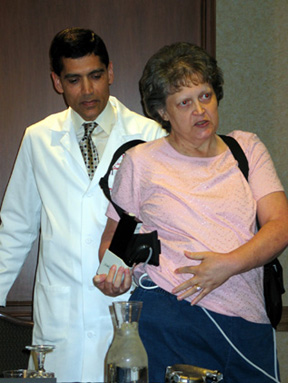 |
Kathryn Stull points out the mechanical device implanted earlier this year by Deepak Gangahar, M.D. The temporary device helps boost heart function and circulation until Stull receives a heart transplant. |
Kathryn Stull of Gothenburg, Neb., is a self-confessed chatterbox. So when she stopped talking, her family knew something was wrong.
“I simply didn’t have the energy to hold a conversation,” Stull said. In fact, she didn’t have energy to do anything but sleep – sometimes up to 17 hours a day.
Stull’s heart was operating at about 8 percent efficiency when she came to The Nebraska Medical Center. That means her blood wasn’t circulating like it should – jeopardizing her vital organs and limbs.
In an effort to keep her heart going, doctors implanted an automatic defibrillator that would shock Stull’s heart if it stopped. “During one night, the defibrillator went off eight or nine times,” Still said. “Once is enough for me. The feeling raises you right off the bed. You can’t control it.”
With the defibrillator onboard, Stull, 55, came to The Nebraska Medical Center where Deepak Gangahar, M.D., chief of cardio-thoracic surgery at UNMC, and his team evaluated Stull and placed her on the waiting list for a heart transplant.
“I had three options: change medications; go on an IV drip; or the HeartMate, which is a left ventricular assisted device (LVAD),” Stull said. “Dr. Gangahar considered the LVAD a last-ditch option because it meant another surgery, which might be too much for my heart.”
“Kate’s condition was deteriorating every day and adversely affecting her other organ systems,” Dr. Gangahar said. “She was on a heart transplant waiting list but we were not getting any donor calls. The only way to keep her alive was with the use of LVAD. By implanting the LVAD, HeartMate, our emergency was over and we could now let her regain the strength that she had gradually lost over the past 6 to 12 months.”
The HeartMate is a mechanical assist device to boost heart function, said Mohammad Quader, M.D., cardio-thoracic surgeon with the Nebraska Heart Institute and a member of the heart transplant team at UNMC. “The device takes over the pump function of a weak heart and restores effective circulation of blood in the patient’s body,” Dr. Quader said.
“In addition to giving complete rest to a weak heart it has an inbuilt ability to increase blood flow when a patient exercises. It is an ideal option for patients who have a very weak heart and are on a waiting list for heart transplantation.”
Stull sums up what the LVAD means to her in three words. “It’s my life,” she said.
“If it weren’t for this device, I’d be in bed or dead. Now I’m walking two blocks a day – and that’s a victory for me. I can go to restaurants and shopping, while waiting for a heart transplant.”
In fact, she can go anywhere her battery packs can go.
“What we did for Kate was ‘bridge to transplant,’ ” Dr. Gangahar said. “Her ultimate treatment is a heart transplant operation. Heart transplant is the gold standard in the treatment of severe heart failure. But patients who suffer from advanced heart failure, cannot be managed with conventional medical means and are not suitable for heart transplant, are then considered for ‘destination therapy’ with LVAD. In this case LVAD is the final treatment for these patients.”
Although Stull needs help doing many of the things she once did alone, she looks at the LVAD as an adjustment. “The device gives you limits, but it gives you freedom,” she said.
Meanwhile, Stull remains on the heart transplant list. There is no telling how long she will wait for a donor heart to become available. She is making the most of her life enjoying her husband, daughter and three grandsons. She also is looking ahead to the time when she can return to Gothenburg and the home she loves and misses.